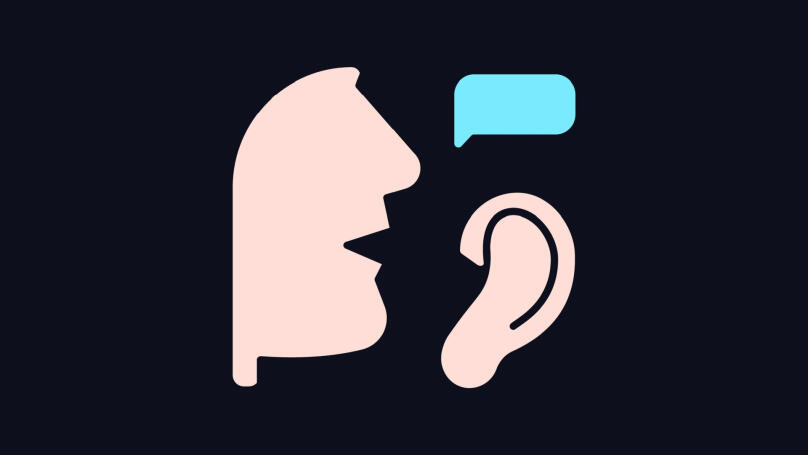Active listening

What is active listening? How important is this skill in the workplace? What is the meaning of it, can it improve the customer service of your company, how can you use it in the call centre and in the social work process? And, most importantly, what role does active listening play in therapy, what strategy should be followed to learn it, and what seven key skills does it require? So many questions and so few answers! But don't worry because we have prepared a detailed overview of this skill and will tell you everything you need to know about it.
What is active listening?
Active listening is a skill that allows you to build trust with your conversation partner and make them feel comfortable enough to continue interacting with you. The definition of active listening suggests that this technique is often used in sales and counselling. Active listening also means remembering information from a conversation and using it to improve the relationship with the person in question. Additionally, it frequently helps you to get what you want. Indeed, all you need to do is perform simple exercises and practice them daily.
This skill has completely different fields of application today. For example, it gets used in children's psychology, training activities, and educational games for adults and students. Active listening in a relationship is an opportunity to please everyone, and active listening in nursing is the best way to express support and empathy. Yes, it has no disadvantages at all. The characteristics of a person who has such a skill and is called a "good conversationalist" are so attractive that learning to listen actively will be helpful to everyone.
Why is active listening important?
Active listening is crucial because you can support a person and show them that you are trustworthy and on their side. It is an essential communicative skill that takes steps to reduce misunderstandings and prevents conflict. Active listening means inviting the other person to open up to you. This set of features allows you to see the world from different perspectives, including perspectives that are contrary to yours, and to bring something to your view that was previously unknown to you. What's more, that's just the beginning of the list of benefits of active listening! The ability to listen also helps you develop patience, which is helpful in your career and personal life. For example, it helps in sales and at different stages of negotiations with clients. When talking to friends and relatives, patience is an excellent help to express your thoughts and feelings honestly.
The other side of active listening skills is a rapid increase in your competence and knowledge pool. The better you listen, the more effectively you perform your work tasks, and the faster you build up your professionalism. Trust me, it will not go unnoticed by your supervisor. Active listening in communication reduces the risk of making a business mistake, losing money, or damaging the company or project. It also includes new opportunities for climbing the career ladder. Moreover, active listening is the key to problem-solving because, through this skill, you as a manager can learn what your employees don't like about their work and what shortcomings they see in their work processes, and you can spot signs of dissatisfaction.
The difference between active and passive listening

People who practise active listening pay particular attention to the person with whom they are conversing. They read the speaker's reasons for saying a specific phrase and show their understanding and sympathy for them non-verbally. Active listening involves body language, such as frequent nodding. Verbal means may include rhetorical exclamations such as "Did you really do that?" to show your interest in the conversation.
So, if this is active listening, what does passive listening look like? Well, according to the books on effective negotiation by Carl Rogers, American psychologist and founder of the client-centred approach, passive listening is the typical conversation you have with others daily. It involves monologue and dialogue in the ten-to-one ratio. The listener does not react as obviously to what the other person is saying, does not comment on their story, and does not show empathy. Some experts believe this behaviour is one of the most striking barriers to active listening that you must address if you want to be a top-class public speaker.
What is the purpose of active listening?
During a conversation, active listening helps to create and reinforce a relationship of trust between you and the other person. It enables you to understand the other person's feelings and to find out the information that interests you. The primary purpose is to make the other person feel heard and appreciated. Moreover, this is one of the often-cited advantages of active listening that coaches often mention. Secondary objectives combine the benefit of learning something, convincing someone of something, and so on.
Types of active listening

There are several types or components of active listening.
- Periphrasis.
Paraphrasing means you repeat the essence of the speaker's words, and then you say something new, whether it is your opinion or questions. It shows that you have concentrated on and understood what the speaker is saying. Practice active listening with paraphrasing, and you will quickly learn the rest of the techniques.
- Reflection.
In active listening, you should always maintain eye contact and support the speaker with your non-verbal reactions. To do this, pay attention to the verbal signs of the person's current state. Firstly, mirror your conversation partner. For instance, if they are talking fast, then talk faster too. If they are sitting reclined in a chair, you lean back too. The important thing is to do this unobtrusively and not copy the person's gestures too fast. If you follow this technique, you will create an emotional connection between you and your companion.
- Periphrasis and reflection.
The hardest part is reflecting and paraphrasing the other person's feelings simultaneously. Nevertheless, you can learn this in months of practice; it is challenging to put the theoretical postulates into practice in the case of the combined type of active listening. But then you will be able to fill in all the items on your checklist for a skilful interlocutor!
How to improve your active listening skills
Try some active listening exercises to improve your active listening skills.
- Look the other person in the eye during the conversation. Adapt this skill to the situation. However, do not frighten people by making eye contact for too long. Five seconds from time to time will be enough. You can stare into one eye for five seconds, five seconds into the other, and then shift your gaze to something near the person or look away for a couple of seconds.
- Study non-verbal signs. Monitor a closed posture (such as arms crossed over your chest), and check your facial expression, tone of voice and gestures. Also, pay attention to the interlocutor's body language, copying it if they are not closing.
- Do not interrupt. Listen to the person's thoughts and ask what you want. Allow them to speak, and you will be a great interlocutor for them. Moreover, a thank you for being attentive may be the information you need.
- Don't jump to conclusions. Listen to what they have to say, and don't react in a judgemental or devaluing manner. It may prevent the person from opening up emotionally. You never know what you will be told next. Therefore, it is not advisable to plan what to say in response before you have heard the whole story.
Active listening techniques
Here are three of the most popular active listening strategies.
Technique One: A comfortable environment.
The first strategy is to show the other person that they can speak up. Establish a relaxing tone of communication, be calm, and give the person time to find their words. Do not interrupt or finish sentences for them. Pay attention to your body language, and remember about eye contact.
Technique Two: Introspection.
Do not draw conclusions from the conversation - paraphrase information and reflect the emotions and feelings of the interlocutor. Express feelings if they can't do it themselves. Be supportive, show that you understand and accept the person and that their reaction is normal.
Technique Three: Questioning.
Don't be afraid to ask. Is there something you don't understand? Clarify it! Don't be scared to ask questions about any ambiguity. You won't be poorly thought of but instead thanked for being considerate of the other person. Use leading questions, but do not ask about something super sensitive and vital "directly," be a gentle and careful interlocutor.
Active listening tips

What other tips for active listening can we give you?
- Summarise. Repeat critical points of the conversation: this will help the other person know that you are on the same page as them and will help you expand your knowledge of them. You can use a periphrasis that touches on all the key points of the conversation.
- Share. Active listening is about dialogue, not submissive silence. Talk about a similar experience, share a thought or idea, but don't draw conclusions until you are sure you understand the person's point of view. Sharing means going through the process of solving a problem, followed by the questions "What else haven't we tried?" and "What else might we not know about this situation?"
Examples of active listening
Here is what active listening might sound like:
- So, you want to build a new house on this property?
- I appreciate you taking the time to talk to me.
- I understand that you are unhappy with the new contractor.
- I was in a similar situation last year when I communicated with the contractor through my manager.
- I understand where you are coming from. So, you're not happy with the new contractor who's supposed to build you a house on this property, right?
Active listening in sales
Active listening in sales is about the same as outside sales. It's just adding the need to sell something to the standard techniques. Listen carefully to the potential customer, even if you think they won't buy anything from you. Observe their facial expressions and gestures and paraphrase their words to confirm their valid emotions. Get a confirmation that you have understood the client's problem correctly. For instance, ask them: "Do you really see that I know the essence of what you have shared with me? I want to solve your problem as effectively as possible." Ask clarifying questions, and try to keep them open and invested rather than looking like automatic chatbot remarks. Once you're clear on the cause of the issue, proceed with the sales pitch-the customer is practically ready to buy anything from you.
You can also learn how to listen actively on Lectera courses: they are free, detailed and practice-orientated. The programmes cover the 'three "A's" of active listening' (Attitude, Attention, and Adjustment), which we've discussed today, and allow you to practice on actual cases. The NLP in Sales programme, for example, will teach you how to listen actively and influence your interlocutor non-verbally. So, register now to secure your spot!























